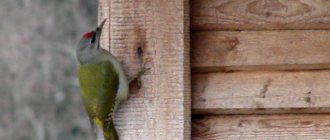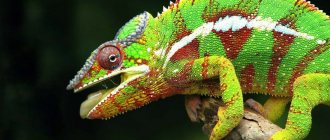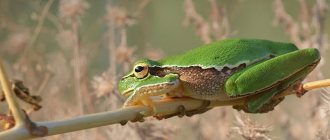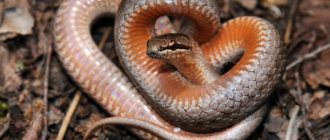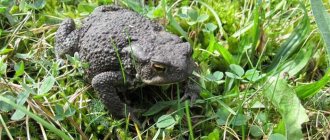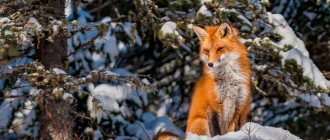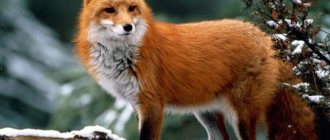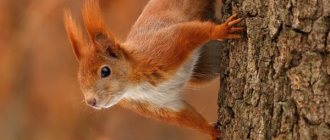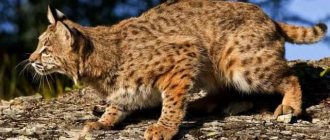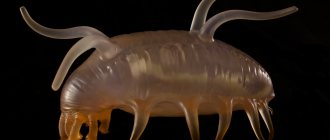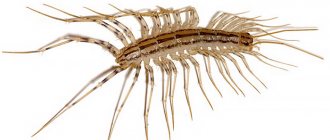Behavior
The common spadefoot lives in areas with moist and loose soil, in which it spends most of its time at a depth of up to 15 cm. Spadefoot spadefoots burrow very quickly, using the keratinized heel tubercles of their hind legs for this purpose. Spadefoot spadefishes dig soft soil well with their hind legs and go underground almost vertically. During the day it sits in a hole, at night it wanders in search of food, but hunts only when the air is sufficiently humid. If the air is dry, the spadefoot will not come out of its shelter, no matter how hungry it is. Adult spadefoots spend the winter (September-April) in the burrows of rodents, moles, shore swallows, and in holes under stumps and fallen leaves.
| Order: Anura Rafinesque, 1815 - Tailless amphibians | |
| Family: Pelobatidae Boulenger, 1882 - Spadefoot | |
| Genus: Pelobates Wagler, 1830 - Spadefoot | |
| Rana | Georgi, 1801 (partim); Pallas, [1814] (partim). |
Pelobates fuscus (Laurenti, 1768)
—
Common spadefoot
Pelobates fuscus fuscus (Laurenti, 1768)
| Bufo fuscus | Laurenti, 1768: 28 (limited type area: Vienna, Austria). |
| Rana vespertina | Pallas, 1771: 458 (type area: Zarbai stream near the village of Ilmen, Samara region); Pallas, 1771: 458, [1814]: 13; Georgi, 1801: 1870. |
| Bufo vespertinus | - Schneider, 1799: 225; Dvigubsky, 1832: 35. |
| Bombinator fuscus | — Eichwald, 1831: 168 (partim?: except the Caucasus). |
| Pelobates fuscus | - Sabaneev, 1874: 186; Bedriaga, 1891: 241; Zarudny, 1896: 363; Nikolsky, 1905: 402, 1907: 166, 1913: 221, 1918: 153 (partim: except Transcaucasia); Vorontsovsky, 1922: 29; Larionov, 1923: 3; Terentyev, 1924: 73, 1935: 55; Dryagin, 1926: 139; Terentyev, Cherno |
Description and taxonomy.
Body length 40-80 mm. The body is stocky, the head is large, the hind legs are short. The inner calcaneal tubercle is very large and brownish-yellow. Above, grayish-yellow, grayish-brown or brown with dark brown spots and small reddish dots. The belly is grayish-white, without a pattern or with sparse gray dots. The forehead between the eyes is more or less convex. Unlike the female, the male has a protruding oval gland on the shoulder, the body is smaller, the color is darker, and the pattern on the back is more contrasting. During the breeding season, the male has small bumps on his palms and forearms.
At the end of the 19th - beginning of the 20th centuries. spadefoot spade from Transcaucasia (Georgia and Azerbaijan) were designated as Pelobates fuscus
.
All these finds relate to areas where another spadefoot spadefoot, Pelobates syriacus,
: the areas of Tbilisi, Belyasuvar, Ali-Bayramli, Mugan and Lenkoran.
Although A.M. Nikolsky argued that Caucasian individuals do not differ in their external morphology from P. fuscus
from European Russia, they are obviously within the range of variability of
P. syriacus
.
Spreading.
The range occupies vast areas from Central Europe to Western Siberia and Kazakhstan.
The northern boundary of the species' range extends to approximately 58o N. This border starts from the Baltic coast of Estonia (Pärnu: 58o23′ N, 24o32′ E) and runs approximately along the line: Pskov and Leningrad regions (Luga district: approx. 58o N) — south of the Vologda region. — southwest of the Kostroma region. (latitude of Kostroma: 57o47′ N) - north of the Nizhny Novgorod region. (Vetluga river valley: approx. 56o47′ N, 45o E) - Kirov region. (Nolinsky district: approx. 57o33′ N) - Udmurtia (cities of Kilmez - Pudem - Votkinsk) - Perm region. (environment of Perm: 58o00′ N, 56o13′ E) - Sverdlovsk region. — Tyumen region. (the easternmost finds are Yalutorovsky and Uporovsky districts, approx. 57o N, 66o30′ E). The spadefoot spadefoot is absent from the Ural Mountains. The southern border of the range in Russia runs from the Black Sea coast in the Ciscaucasia (Krasnodar Territory, Novorossiysk region, Abrau Peninsula: approx. 44o43′ N, 37o30′ E) to the city of Goryachiy Klyuch, then to Stavropol Territory (Verkhny Yankul village), Chechnya (Grozny: 43o19′ N, 45o40′ E and the village of Starogladkovskaya) and Dagestan (the territory between the Kuma and Terek rivers: approx. 46o E) , then turns and runs north and northeast approximately along the line: Black Lands in Kalmykia (approx. 48o N, 44o E) - north of the Volgograd region. (Staropoltavsky district near the border with the Saratov region and north-eastern Kazakhstan: approx. 50o30′ N, 47SUP>ov.). Then the range boundary turns east to Kazakhstan. Pelobates fuscus fuscus
lives in the USSR .
From the steppe between the rivers Bityug, Don and Ikorets in the Voronezh region. was described by Pelobates fuscus campestris
Severtzov, 1855. This is not a valid subspecies. In the European part of Russia, according to genetic data, 2 geographical populations are distinguished (Borkin et al., 2003).
Lifestyle.
The common spadefoot inhabits a wide range of biotopes, including various coniferous, deciduous and mixed forests and their edges, groves, steppes, fields, meadows, parks and gardens. In forests, the spadefoot moth chooses open areas. On the eastern border of the range, the species is most numerous in subtaiga forests (mainly in pine forests), in the northern forest-steppe - in open biotopes, in the southern forest-steppe - in coppice fields and meadow areas, in the steppe - in halophytic meadows in fields, less often - on rafting grounds fresh lakes and other biotopes (Ravkin et al., 1996). Here the spadefoot spadefoot prefers non-floodplain biotopes, and only in the southern forest-steppe is the opposite observed. To the south of the Kurgan region the species reaches semi-deserts. As in other parts of its range, it uses irrigation canals here as routes for dispersal. In arid conditions it is found on sand, in wormwood steppes, etc. Here the spadefoot spadefish lives in close proximity to water bodies. On land it leads a semi-burrowing lifestyle, hiding during the day in short burrows in the soil. Spawning and early development usually occurs in permanent, stagnant, more or less deep bodies of water, covered with dense herbaceous vegetation: in ponds, lakes, flooded quarries, ditches, etc. The banks of such reservoirs are usually flat.
Wintering from September - early October to mid-March - April. In the south of the European part of the range, these dates shift to March - late October (until November). Overwinters in the soil. Breeding in March - May (depending on latitude), but sometimes breeding extends until June. Males scream underwater and do not form choirs. Amplexus inguinal.
Metamorphosis in July - September. Young fish that have recently completed metamorphosis bury themselves on the banks and often spend the winter there. In other cases, tadpoles overwinter in ice-free bodies of water and metamorphose the following spring or fall. Such tadpoles reach especially large sizes (over 100 mm). Their metamorphosis usually occurs in May - June. Due to the long period of development, the species is sensitive to the quality of the reservoir.
Tadpoles feed on detritus, plants, and lower animals. Adults consume crawling forms of invertebrates; fast flying insects are eaten less frequently. The spadefoot uses the tactic of actively searching for prey. In 5 hours. During night hunting, an individual examines an area of approximately 200 m2 (Leontyeva, 1987, 1988).
State of populations
The common spadefoot is sensitive to water quality and soil structure. Pollution of water bodies with industrial waste, pesticides, mineral fertilizers, livestock, household waste, etc. dangerous for her tadpoles. Other types of human activity (destruction of grasslands, especially by livestock, urbanization, recreation, open wells in areas where spadefoot moths are concentrated, etc.) also have negative consequences. For example, the destruction of water meadows in one point of the Belgorod region led to the complete disappearance of the spadefoot spadefoot for 6 years (Gogoleva, 1987). On the other hand, certain types of human activity (creating clearings in forests, creating irrigation canals, etc.) lead to local spread of the spadefoot spadefoot. The spadefoot spadefoot is found in villages and even in large cities where there are suitable biotopes. The common spadefoot spadefoot is a widespread and abundant species in Russia. Listed in the Red Books of the Krasnodar Territory and the Middle Urals (Perm and Sverdlovsk regions); was recommended for inclusion in the Red Book of the Chechen-Ingush Autonomous Soviet Socialist Republic as a rare and poorly studied species (Anisimov, 1989). Lives in 17 (or 21) nature reserves in Russia.
Literature… Read more
- Aleynikova, Utrobina, 1951; Aleksandrovskaya et al., 1979; Ammon, 1928; Ananyeva et al., 1998; Andreev, 1953; Anisimov, 1989; Astradamov, 1975; Bazanova, Dyakov, 1975; Bannikov, 1955; Bannikov et al., 1971, 1977; Blinova, Blinov, 1997; Bolotnikov et al., 1967; Borkin, 1979, 1984b; Borkin, Darevsky, 1987; Borkin, Krever, 1987; Borkin et al., 1997; Vorontsovsky, 1922; Vysotin, Tertyshnikov, 1988 Garanin, 1964b, 1983; Garanin, Shaldybin, 1976; Garanin, Ushakov, 1969; Gogoleva, 1987;, 1989; Gorovaya, Dzhandarov, 1987; Guseva, Okulova, 1998; Guskov et al., 1983; Dvigubsky, 1832; Dementyev et al., 1951; Dinesman, 1953; Dorovatovsky, 1913; Zarudny, 1896; Kaletskaya, 1953; Kireev, 1983; Queen, 1976; Kotenko, 1987; Krynitsky, 1837; Kubantsev, Kolyakin, 1988; Kuzmin, 1989, 1991g, 1994c, 1995a, 1996a, b, 1997a; Kuzmin et al., 1996; Lada, 1993; Larionov, 1923; Lebedinsky, 1995; Leontyeva, 1988, 1990; Medvedev, 1974; Meshkov, 1958; Nikolsky, 1905, 1907, 1913, 1918; Nosova, 1984, 1990; Okorokov, 1964; Pallas, 1771, [1814]; Panchenko, 1984, 1986; Polozhentsev, Khanislamov, 1942; Polushina, Kushniruk, 1962; Ponomarev, 1984; Pryalkina, 1989; Ptushenko, 1934; Ravkin et al., 1996; Rumyantsev, 1926; Ryzhikov et al., 1980; Sabaneev, 1874; Severtsov, 1855; Sigov, 1936; Slyusarev, 1983; Starikov, 1986; Terentyev, 1924, 1935; Terentyev, Chernov, 1936, 1940, 1949; Tertyshnikov et al., 1993; Toporkova, 1966, 1973; Toporkova, Menshchikov, 1974; Tochiev, 1987; Ushakov, 1968; Khokhlov, 1993; Sharygin, Ushakov, 1979; Shlyakhtin, 1985; Shcherbak, 1966; Shcherbak, Shcherban, 1980; Eichwald, 1831; Yushkov, Voronov, 1994; Yanushevich, 1976; Yaremenko, 1959; Amphibian, 1995; Boettger, 1899; Boulenger, 1897; Georgi, 1801; Gorham, 1963; Kauri, 1946; Mertens, Wermuth, 1960; Nollert, 1997; ZMMGU; V.A. Yudkin, V.N. Blinov, Yu.S. Ravkin, in letters; unpublished author data.
The largest tree frogs
Our list would be incomplete without tree frogs, which spend most of their lives on tree branches. The largest representatives of this family are:
Long-legged litoria / Litoria infrafrenata
A cute amphibian with a grassy green color and a lighter belly.
Legs – elongated, long. The front toes have light pink suckers. There is a characteristic edging around the lips. Size in length - from 10 to 13.5 centimeters. The skin is rough with a slight bumpiness. Weight: about 400 grams.
Lives mainly in Australia, on the adjacent islands. Settles in woody areas, including high in the mountains.
Cuban tree frog / Osteopilus septentrionalis
One of the largest representatives of the tree frog family, growing up to 14 centimeters in length (males are two to three times smaller than females). Weighs approximately 200 grams.
It looks quite elegant thanks to the elongated size of the fingers with roundish suction cups. The upper part of the body of this tree frog is gray-greenish, with spots. The belly is lighter in tone. In addition to Cuba, he lives in the Bahamas and in some areas of Florida.
Interesting: A distinctive feature of the species is the ability to change color, adapting to the shade of the wood on which it sits.
Marsupial tree frog / Gastrotheca
The sizes of these amphibians range from 3 to 10 centimeters and weigh up to 50 grams. Habitat: tropics of South and Central America.
They got their name because of the peculiarity of childbirth. They “bear” the laid eggs in special bags located on the stomach. The hatched tadpoles spend several months in this reliable shelter, after which the female pushes them into the water, outside, where they spend another couple of months, becoming full-fledged frogs.
